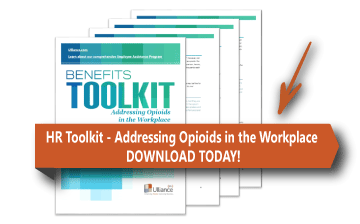Opioid Addiction Can Threaten Your Workforce ► Counter low productivity, higher health care costs, and distracted workers with these 3 steps.
The opioid crisis in the United States touches people from all walks of life. Every economic class, every race, every profession.
As opioid prescriptions increase, so, too, does addiction, abuse and overdose deaths. According to the Centers for Disease Control, opioids were involved in 47,600 overdose deaths in 2017, accounting for 67.8 percent of all drug overdose fatalities. Employers across the country are working to curb the misuse of prescription opioids. With more employees falling victim to addiction, employers are seeing lower productivity, higher health care costs and fewer qualified
job applicants.
As more employees become addicted to opioids, manufacturing employers face a particularly high threat— given the risks associated with workers operating machinery and the environment of a manufacturing facility.
The best way to protect your organization and your colleagues from the dangers of opioid use is by a proactive approach, rather than trying to solely combat abuse and addiction after it is too late.
Consider taking these three proactive steps in the fight against opioid abuse.
1. Create a drug-free workplace policy—and communicate it
By establishing a drug-free workplace policy, you’re creating a safe, drug-free environment for employees and others who visit your facility. When you communicate your policy, you’re also clearly outlining the organization’s stance on abuse. Your drug-free policy can be used as an opportunity to discourage addiction and abuse, while encouraging effective treatment and recovery solutions.
2. Educate employees
Opioid addiction can impact every aspect of an employee’s life, from job performance and on-the-job safety to overall health and well-being. And, unfortunately, opioid addiction can lead to far worse consequences, such as permanent injury and even death. While becoming addicted to opioids can be the result of legitimate injuries and doctor-prescribed pain medications, it is
essential to educate employees on the entire topic of opioids. Address the issues of prescription opioid addiction, pain-management alternatives, what to do should they find themselves struggling with addiction, when to seek help and from whom and more.
3. Use your Ulliance Employee Assistance Program (EAP)
EAPs can be extremely beneficial for your workforce. Traditionally, the services provided by an EAP help with personal health and wellness issues, like nicotine cessation or stress management. However, they can also be applied to cases of opioid usage. An EAP that is specifically tailored toward opioids and employees dealing with the debilitating addiction can support improved health and on-the-job productivity.
When so much of the workforce is at risk of opioid abuse, it is crucial to have a plan in place before you need one.
More than 47,000 people die from opioid overdoses each year. Be a part of the solution by knowing opioid addiction risk factors and signs. If you or someone on your team is struggling with addictive painkillers, talk with Ulliance, Inc. We have the resources to help.
How can we help you?
Visit www.ulliance.com, or call 866-648-8326.


